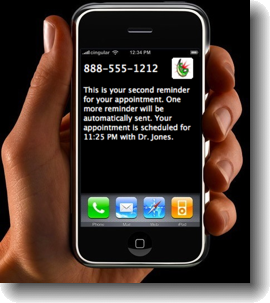Commercial
Private Waiting Room
Background
With No-Q Systems Pty Ltd., based in Lathlain, Australia, PingerWare is developing groundbreaking technology to address the bottlenecks in patient scheduling in the modern medical office. Millions of patients are seen each year by health service providers. Private Waiting Room (PWR™) works with the medical office to provide freedom for these patients during the waiting period before seeing the health service provider. PingerWare believes that this will optimize patient waiting times, reduce patient exposure to viruses and other pathogens, increase efficiency and patient management, and to increase the medical clinic customer appeal and staff satisfaction in the medical clinics' waiting rooms. The patients are free to leave the waiting room and go elsewhere while periodic reminders are sent to them electronically. Changes in their schedules are immediately transmitted to the patients so that schedules overall at the clinic can be optimized for faster patient throughput. This means shorter wait times, better management of the provider's time, and overall higher quality service.
PingerWare is developing PWR™ as an automated patient/client notification system. PWR™ is comprised of a standalone software client application interacting with a commercial SMS server system. PWR™ is used by the office worker who is checking in the patient and enters in basic patient demographics information. Alternatively, PWR™ can receive HL7 standards-based patient demographics data automatically from an HL7 compliant office patient scheduling software. This information is used to create outbound reminder messages that are transmitted to the patient automatically at the proper intervals.
Benefits for the Clinic Manager
- Enables each doctor's waiting list to be managed independently but still coordinated by a single practice management system.
- Patient is notified automatically of a change in schedule.
- The clinic and its patient flow is enabled with increases in efficiency and a reduction in the stress and failed-to-attend rates.
- Reduces the number of patients in the waiting room with a potential to free up waiting room space and to change the waiting room design.
Benefits for the Patients
- Avoid exposure to other (sick) patients for prolonged periods of time.
-
Receive automatic updates on wait times.
- The opportunity to wait in a quiet surrounding of their choice.
- Manage waiting time productively.
- Mothers with new babies and toddlers are able to devote attention to a sick child or to feed and change babies away from the waiting area.

Advantages
- Addresses an unmet need in local clinic and larger hospital patient management systems
- Operates as an add-on enabling system.
- Assists with the management of pandemic viruses, e.g., H1N1, bird flu, SARS,and emerging diseases
-
Mitigates the day-to-day virus transmission between different cohorts of the community:
- baby
- infant
- preschoolers
- teenagers
- young adults
- the aged
Effective Waiting Rooms
- Minimize hard costs of space and seating capacity
- Minimize inter-patient viral transmission
- Improve productivity of office manager and reduces stress of managing a crowded waiting room
- Drives other organizational improvements, productivity, and efficiencies
- Increases patient satisfaction, and heightens staff morale, thus reducing stress
Platforms Supported
- Windows (7, Vista, XP)
- Macintosh (OS X - Intel, PPC)
- Linux

